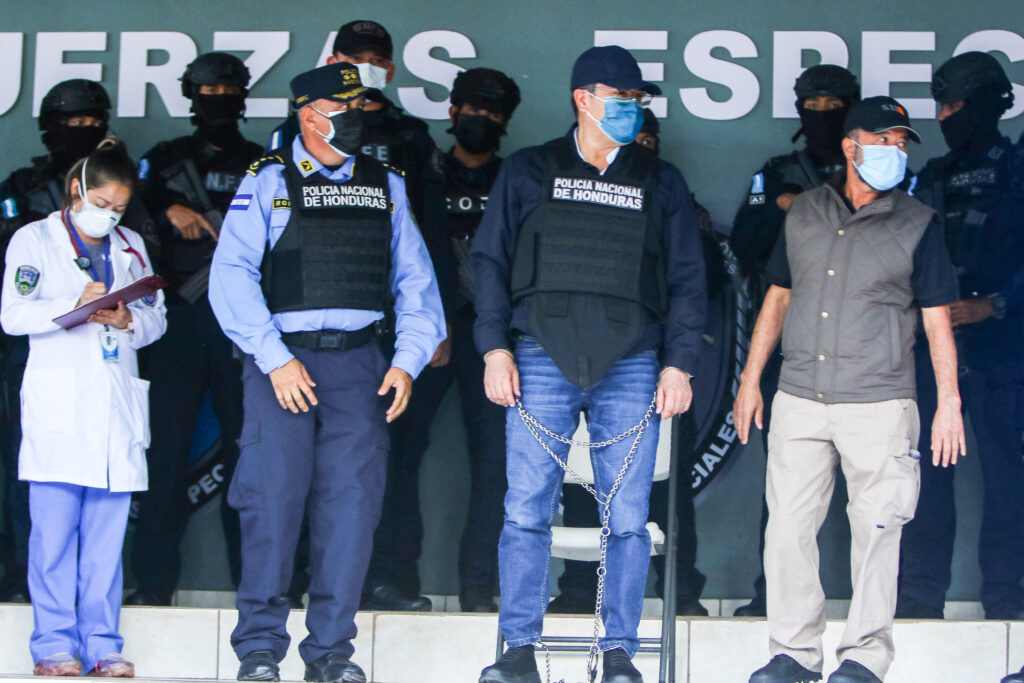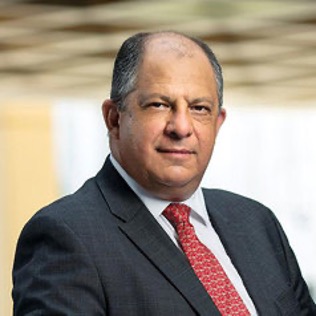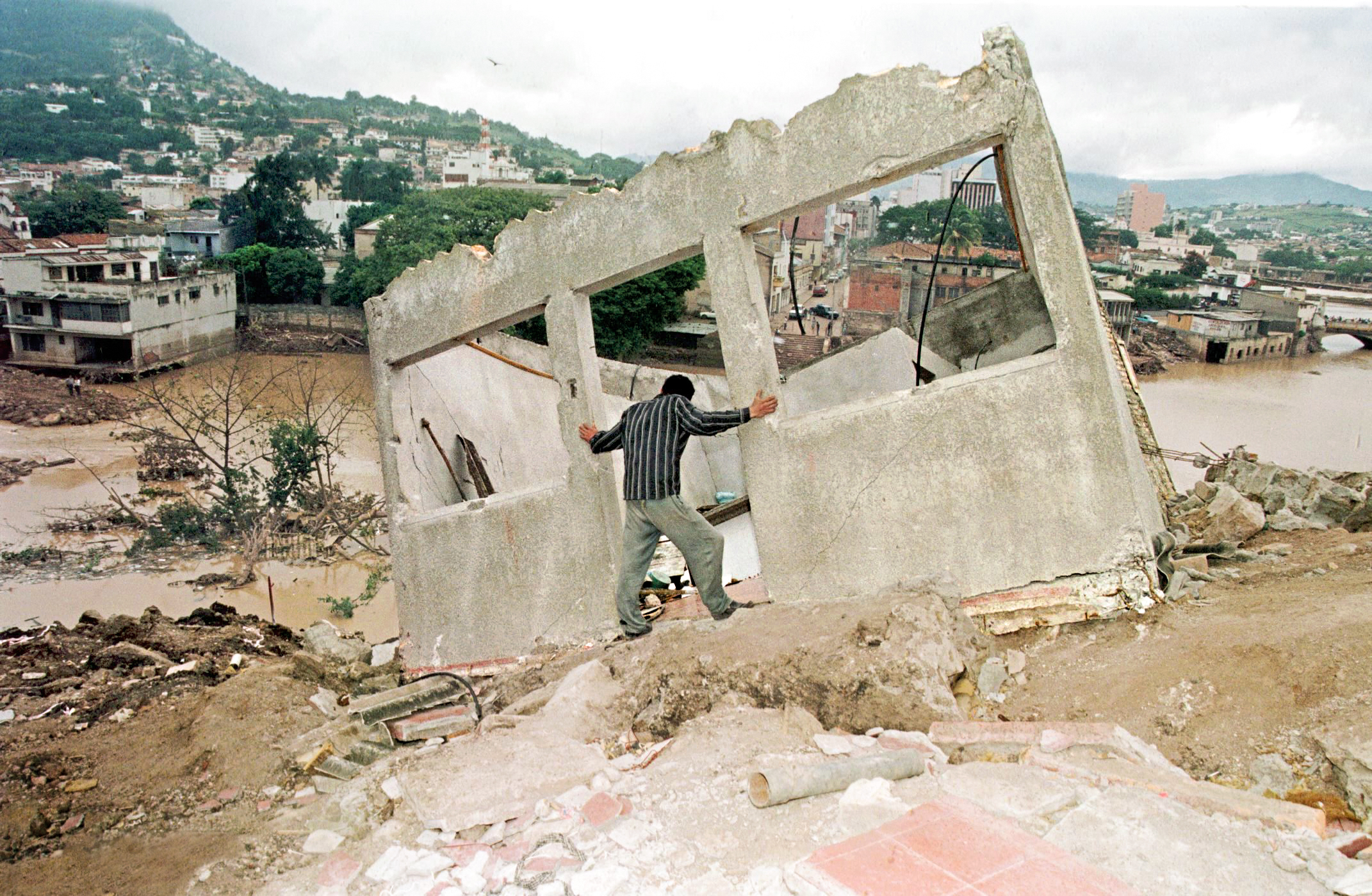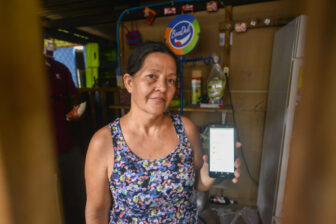This article is adapted from AQ’s special report on the Summit of the Americas
Everyone knew Hurricane Mitch would be brutal. Before the Category 5 storm began dumping water on Central America in October 1998 with sustained wind speeds of 180 miles per hour, atmospheric scientists had warned it would be among the strongest Atlantic hurricanes on record.
But no one expected Mitch to slow to a crawl, hovering mercilessly for days on end above Honduras, its arms sucking up water from both the Caribbean Sea and the Pacific Ocean and pouring it back down on the land, catching politicians and ordinary citizens hopelessly off-guard. Despite the advance warning, authorities in the Honduran capital, Tegucigalpa, were unable to find shelter for the many people living in informal dwellings near the banks of the rivers before torrents washed them away. When the storm hit, cliffs collapsed, along with houses built on them.
At the Casita volcano in Nicaragua, rain filled up the volcano’s crater and caused it to partially collapse in a cataclysmic landslide that killed 1,500. A rare ray of light came from the Mayan ruins at Copán in Honduras that survived—testimony perhaps to that ancient civilization’s mastery of drainage systems.
By the time the rains subsided, at least 11,000 people lay dead. The whole region bore Mitch’s impact, but Honduras and Nicaragua were hardest hit, suffering 7,000 and 3,800 dead, respectively. While countries such as Costa Rica and Belize largely escaped the worst human toll, the economic impact was widespread and severe. Mitch washed away crops; banana production on Honduras’ Caribbean coast was almost totally wiped out and would take years to recover. Twenty percent of Honduras’ population was left homeless, and as a direct result of the hurricane, the country’s economy shrank by nearly 2% in 1999, and was left wounded for many years to come.
A Central American renaissance interrupted
Indeed, seen from today’s perspective, Hurricane Mitch was more than just a storm. It put an end to a decade of unusual optimism in Central America, an enduring blow from which the region has still not fully recovered—and a cautionary tale for what could happen again in this era of extreme climate change unless societies heed its lessons.
The 1990s had been a time of growing peace, cooperation and economic growth in the region, as the republics of Central America experienced a period of moderate but increasing well-being. Yes, many of the challenges faced by the region, such as poverty, self-serving elites and the lack of a strong middle class, were still present. But the Cold War was over, and the Esquipulas Peace Accords set terms for the end of Central America’s armed conflicts of the 1980s.
Reaping the benefits of expanding U.S. markets, the region’s economies grew 3.5% to 4% per year even as countries recuperated from the devastation of war and dealt with rising crime. Central America seemed destined for an age of pluralism, respect for human rights and the rule of law—one in which democracy promised better conditions for the poor. And meanwhile, the region was opening to the world, as leaders from around the world paid visits and multilateral financial institutions included Central American countries in major campaigns to ease financial pressures and even eliminate their foreign debts.
But Mitch also shattered the illusion of regional integration conjured by the rebirth of the Central American Integration System in 1991. Instead of seeking a joint recovery strategy, Central American nations engaged in frantic competition for relief funds from the international community. If the relief effort was free of the allegations of massive corruption that had clouded previous campaigns, such as in Nicaragua after a 1972 earthquake in Managua, the atmosphere of national jockeying undermined budding regional cooperation on other fronts, such as security, social investment and tourism strategies.
A shock to an already vulnerable system
The improvements in Central American democracy over the 1990s proved all too vulnerable to a shock like Mitch. Countries became increasingly vulnerable to crime and narcotrafficking as poor, segregated neighborhoods in the region’s large cities became centers of operation for violent gangs formed by Central Americans deported from the U.S. to their countries of origin in the early 1980s. Problems long faced by the region—such as poverty, inequality and social exclusion—worsened as progress slowed, then went into reverse.
For a time, the region’s politics preserved a semblance of normality. But now, two decades after Mitch, democracy has deteriorated so much that it has begun to resemble the grim conditions of the mid-1970s. If the region’s armed forces have largely refrained from direct meddling in politics, signs of trouble are everywhere.
Since 1999, a new dictatorship under the iron fists of Daniel Ortega and his wife, Rosario Murillo, has been consolidated in Nicaragua. An extremely popular autocrat governs El Salvador with complete disrespect for the separation of powers and the rule of law. Guatemala’s institutions are in severe disarray, vulnerable to organized crime, unaccountable for and unable to prevent the constant violation of human rights.
Honduras struck a lighter note in November 2021, with the election of a woman, Xiomara Castro, in a moment that raised hopes for the arrival of much-needed legitimacy and transparency. But even Panama and Costa Rica, the two most stable nations in Central America, face increasing polarization and growing inequality. Belize remains in a category of its own, but its links to its neighborhood have weakened as it moves into a leadership transition. Meanwhile, the COVID-19 pandemic ravaged the region, damaging its economies and straining its health systems. Anti-vaccine sentiment has limited the reach of immunization policies and prevented the limitation of tourist arrivals. In early March, 1 million doses of the Sputnik vaccine expired in Guatemala, where less than half of the population was fully vaccinated.
Slow growth traps the region in poverty
Since 1998, many of the regimes that have ruled Central America have failed to provide a timely response to popular demands, despite having been elected in free and fair elections. A big part of that failure has been the weakness of the region’s economies. Growth rates lagging below 3% or dipping into negative territory fall far short of what’s needed to provide opportunity for the region’s poor. Several countries continue to have poverty rates over 50%, and poverty is believed to have worsened over the course of the pandemic—while climate experts predict the effects of climate change will increase the number of people at risk of malnutrition in Central America over coming decades.
Poverty is in turn a principal cause of outward migration from the region. Without reliable public services such as healthcare, education, drinking water, housing, public security and care for children and senior citizens, life for most Central Americans is painful. Millions have ventured north to the U.S. or south to Costa Rica and Panama in search of a better life.
To finance quality public services, the obvious option for Central American countries would be to introduce a progressive taxation regime. But thanks to opposition from national elites, this has not been possible. These powerful segments of society have helped make Central America the region with the lowest rates of taxation in the Western Hemisphere. With neither taxation nor economic growth to finance social investments, most Central American countries have resorted to debt spending, with the result that the region is subject to the imposition of austerity policies by multilateral financial institutions.

A corrosive cycle of corruption
The region’s problems aren’t only economic. Organized crime has also taken a toll. But no other factor has been more detrimental to democratic legitimacy than corruption. Under dictatorship and democracy alike, in conservative as well as purportedly progressive administrations, the region’s governments have been marred by embezzlement, fraud, bribery, money-laundering and other unlawful activities related to narcotrafficking.
In one well-known case in 2019, a Guatemalan presidential hopeful was caught plotting the murder of two of his adversaries and the sale of favors to traffic drugs through Guatemala, for $14 million dollars. A few years earlier, former Salvadoran President Mauricio Funes escaped to Nicaragua after being accused of embezzling more than $350 million dollars from his country’s treasury. In February 2022, two weeks after Honduras’ former President Juan Orlando Hernández left office, the U.S. requested his arrest and extradition for his presumed involvement in drug-related activities.
Cases like these, frequently discussed on social media, have turned public opinion against the region’s political class in general. It’s not only politicians who are now seen with suspicion, but also officials and other decision-makers in the public sphere.
Likewise, the weakening of political parties and ideological contestation has not been an improvement for the region’s politics. As doctrinal consistency has been replaced by lawfare, fake news and improvisation, populism is on the rise—and in Central America as in other parts of the world, it has been prone to extremism, violence and religious fundamentalism.
Is class structure to blame?
But perhaps even more than slow growth, poverty, corruption or political woes, the ultimate explanation of liberal democracy’s weakness in Central America lies in the absence of strong middle classes. In most Western democratic societies this group, sometimes called the bourgeoisie—whether liberal professionals, public employees, entrepreneurs or skilled laborers, urban or rural —became the backbone of material progress and political stability. A strong middle class is perhaps the best antidote against radicalism, and a natural buffer between the elites and the dispossessed.
Costa Rica provides the best example of how a strong public sector can anchor a robust middle class—and the stabilizing effect of this class may explain the difference between it and much of the rest of the region. Without a middle class, it becomes difficult to guarantee upward mobility, diversify productive sectors, provide quality public education and healthcare, and promote the orderly development of urban dwellings—which would do much to protect societies from the impact of another Mitch.
But a middle class can’t be improvised. To develop one requires trading violence and institutional weakness for dialogue and the rule of law—and that, in turn, requires all the things Central American elites seem to lack: wise, responsible leadership, political acumen, international solidarity and a focus on achieving economic success.
Can this vicious cycle of poverty, injustice and violence give way to a virtuous cycle of democracy, welfare and peace? Probably. The experience of the 1990s shows Central America, when ruled by leaders willing to think beyond their limited time frames, can make strides on its developmental challenges. When good leadership coincides with a favorable international context, the results can be extraordinary. Though the immediate future seems bleak, there is room for cautious optimism in the medium and long term. As the saying goes, it’s always darkest before the dawn.









